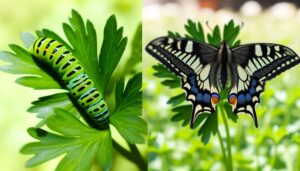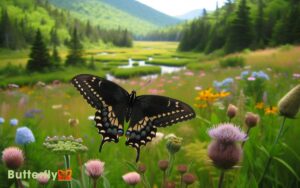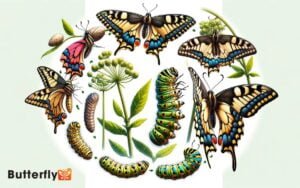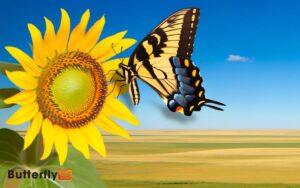Identifying and Caring for Two Tailed Swallowtail Butterfly Caterpillars
The Two Tailed Swallowtail Butterfly Caterpillar, scientifically known as Papilio multicaudata, inhabits riparian woodlands and gardens throughout North America, with notable prevalence in the western United States and Mexico. Early instars mimic bird droppings for camouflage, while later stages exhibit vivid green with yellow and black markings.
They feed on leaves of ash (Fraxinus spp.), chokecherry (Prunus virginiana), and hoptree (Ptelea trifoliata). Equipped with eversible osmeteria, the larvae employ Batesian mimicry as a defense mechanism.
Progressing through multiple growth stages, they eventually form a chrysalis, culminating in the emergence of an adult butterfly. Those interested will uncover more intricate details about their fascinating life cycle and conservation.
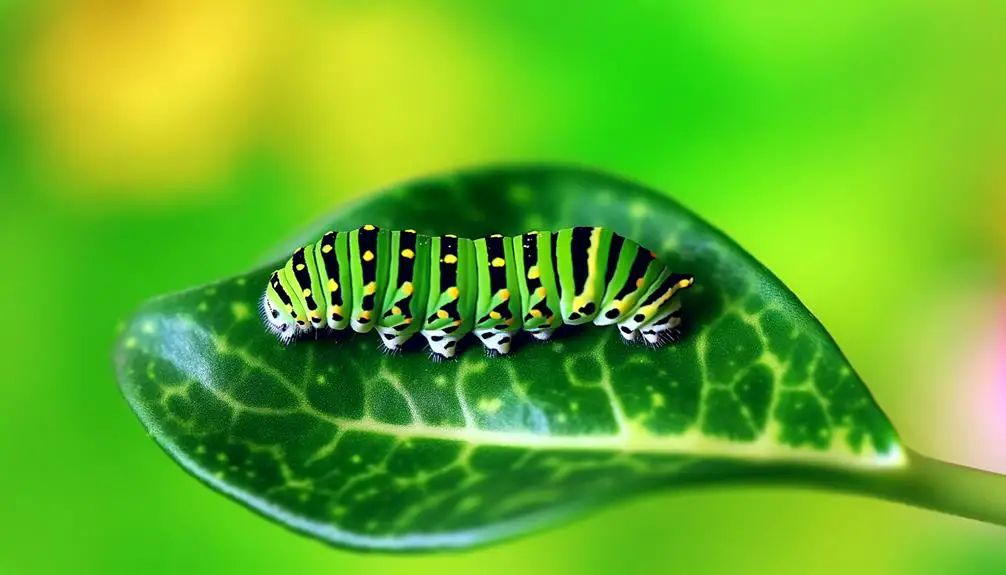
Key Takeaways
- Two Tailed Swallowtail caterpillars inhabit riparian woodlands, gardens, and orchards across North America, primarily in the western United States and Mexico.
- Early instar larvae mimic bird droppings for camouflage, while later stages are vividly green with yellow and black markings.
- The caterpillars have defense mechanisms including eversible osmeteria that release foul-smelling secretions when threatened.
- They primarily feed on the leaves of Rutaceae and Rosaceae plants, showing a preference for genera like Citrus, Ptelea, and Prunus.
Habitat and Distribution
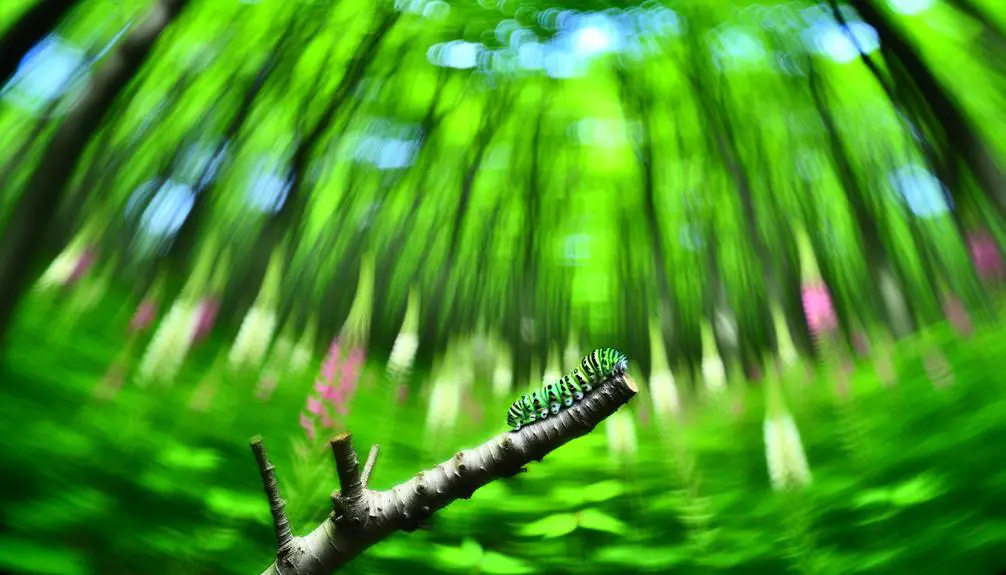
The Two Tailed Swallowtail Butterfly caterpillar (Papilio multicaudata) mainly inhabits riparian woodlands, gardens, and orchards across North America, with a notable concentration in the western United States and Mexico.
These habitats provide the ideal microclimate and vegetation necessary for larval development.
Preferring altitudes ranging from sea level to 2,500 meters, Papilio multicaudata thrives in areas where host plants like ash (Fraxinus spp.), chokecherry (Prunus virginiana), and hoptree (Ptelea trifoliata) are abundant.
The caterpillar's distribution is influenced by the availability of these specific larval host plants, which are essential for its survival and development.
Such diverse habitat preferences underscore the species' adaptability, making it a resilient component of the ecological communities it inhabits.
Physical Characteristics
Exhibiting a remarkable example of morphological adaptation, Papilio multicaudata caterpillars display distinct coloration and structural features at various developmental stages.
Initially, the first instar larvae are brown and white, mimicking bird droppings—a deceptive camouflage. As they progress to later instars, their appearance shifts to a vivid green with lateral yellow and black markings.
The body is adorned with fine setae and a pair of osmeteria, glandular structures everted when threatened. These caterpillars possess a segmented body, with prolegs providing locomotion and grip.
The distinct cephalic horns further contribute to their unique morphology. Such adaptations facilitate their survival in diverse environments, reflecting intricate evolutionary processes within the Papilionidae family.
Mimicry and Defense
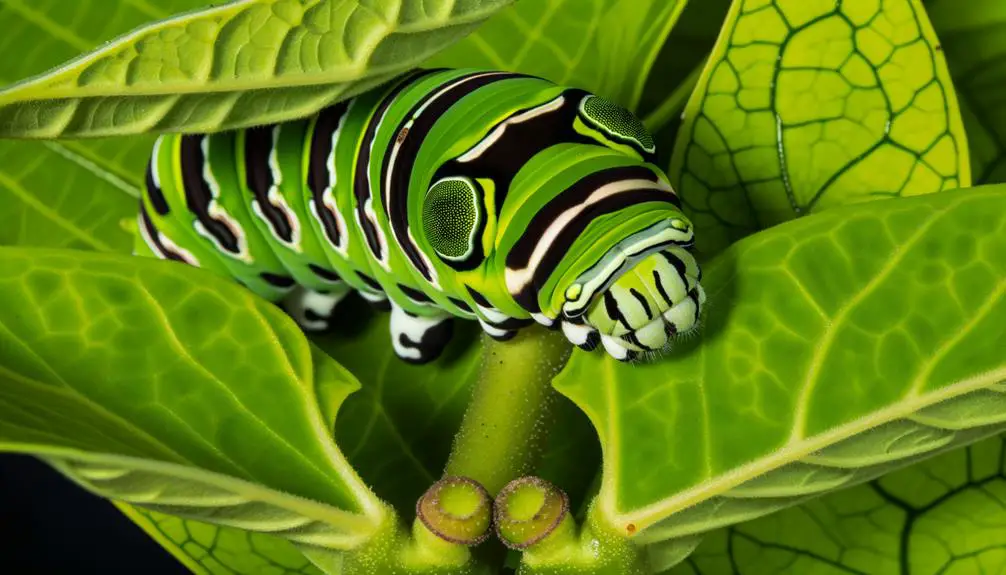
Papilio multicaudata caterpillars employ Batesian mimicry and sophisticated defense mechanisms, such as the eversible osmeteria, to deter predators and enhance survival. Batesian mimicry allows these larvae to resemble unpalatable or harmful organisms, thereby deceiving potential predators.
The osmeterium, a specialized glandular organ located behind the head, can be everted when the caterpillar feels threatened. This structure releases a foul-smelling secretion composed of volatile compounds, which serves to repel predators effectively.
Additionally, the caterpillar's cryptic coloration and patterns blend seamlessly with the host plant, providing camouflage against avian and insect predators. These defense strategies, deeply ingrained within the Papilionidae family, are essential for the caterpillar's development and eventual metamorphosis into the two-tailed swallowtail butterfly.
Diet and Feeding Habits
Caterpillars of the species Papilio multicaudata primarily feed on the leaves of host plants within the Rutaceae and Rosaceae families, utilizing specialized mandibles to efficiently consume their preferred foliage.
Significantly, they exhibit a preference for genera such as Citrus, Ptelea, and Prunus, which provide essential nutrients for their development. Their feeding behavior is characterized by nocturnal activity, reducing predation risks.
Larvae demonstrate selective feeding, targeting tender, nutrient-rich leaf tissues while avoiding older, tougher foliage. This dietary specialization, coupled with their ability to detoxify plant secondary metabolites, underscores their adaptation to specific ecological niches.
Understanding these feeding habits is vital for conservation efforts, particularly in preserving their natural habitats and host plant availability.
Growth Stages
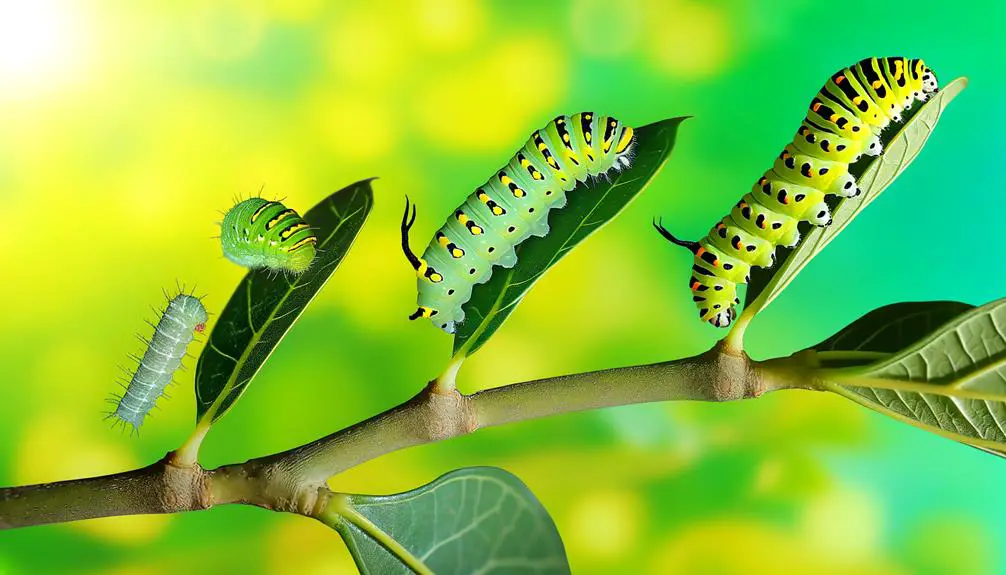
The development of the Two Tailed Swallowtail Butterfly Caterpillar (Papilio multicaudata) encompasses several distinct growth stages, each marked by specific morphological changes.
During the early instar stages, the larva exhibits cryptic coloration and mimics bird droppings to avoid predation.
As the caterpillar undergoes molting, it progresses through successive instars, each characterized by increased size and alterations in patterning and coloration.
Early Instar Characteristics
During the early instar stages, larvae of the Two Tailed Swallowtail Butterfly (Papilio multicaudata) exhibit significant morphological and physiological changes that are essential for their development.
Initially, the larvae are minute, approximately 2-3 mm in length, and primarily black or brown with white markings, providing effective camouflage against predators. The body is equipped with small tubercles and setae, aiding in sensory perception.
As they progress through successive instars, their coloration and patterns undergo notable transformations, including the development of characteristic false eye spots, which serve as a defensive mechanism. The larvae's cuticle, a multi-layered exoskeleton, also thickens, enhancing protection.
These early instar characteristics underscore the intricate adaptations that facilitate survival and growth in their natural habitat.
Molting and Development
As Two Tailed Swallowtail Butterfly larvae shift through their developmental stages, the process of molting, or ecdysis, plays a vital role in accommodating their rapid growth and morphological changes.
Classified under Papilio multicaudata, these larvae undergo multiple instars, each characterized by a shedding of the exoskeleton. This cyclical process allows the caterpillar to expand both in size and complexity, facilitating necessary physiological adaptations.
During each molt, hormonal changes, particularly involving ecdysteroids, trigger the detachment of the old cuticle and the formation of a new, larger one. Observations indicate that the frequency and success of molting are essential for the larva's progression to pupation, ultimately ensuring the emergence of a healthy adult butterfly.
This dynamic growth underscores their adaptability and resilience.
Predators and Threats
Many natural predators, including birds, spiders, and wasps, pose significant threats to the Two Tailed Swallowtail Butterfly Caterpillar (Papilio multicaudata) throughout its developmental stages.
Avian species often prey on these larvae due to their relatively slow movement and conspicuous coloration.
Arachnids, particularly orb-weaving spiders, trap caterpillars in their webs, exploiting their vulnerability.
Hymenopterans, such as parasitic wasps, represent another formidable threat; they lay eggs on or within the caterpillar's body, leading to internal parasitism and eventual death.
Additionally, ants (Family: Formicidae) may attack caterpillars directly or consume them opportunistically.
The cumulative predation pressure from these diverse taxa plays a significant role in regulating Papilio multicaudata populations, influencing their survival rates and distribution within various ecosystems.
Transformation Process
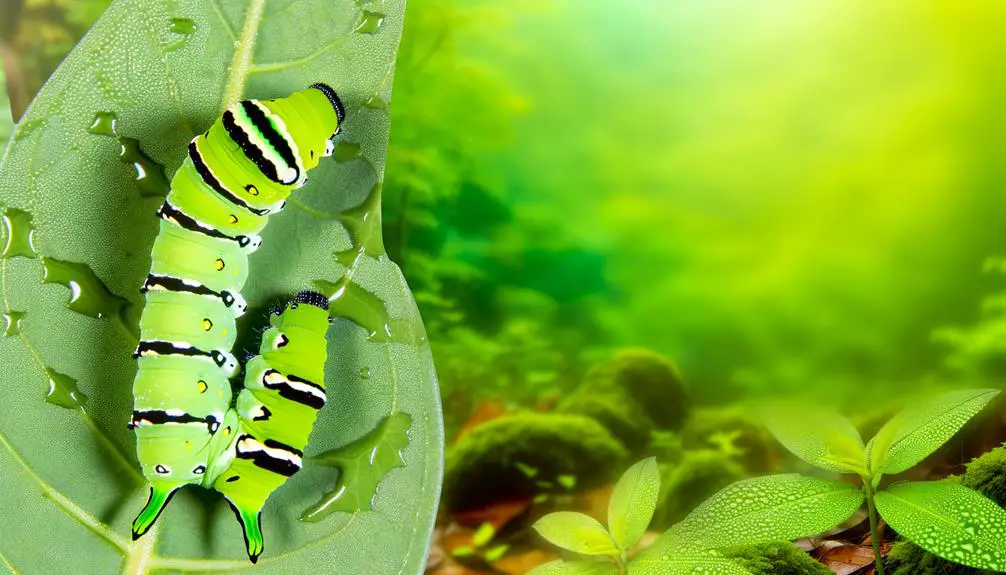
The transformation process of Papilio multicaudata encompasses several critical stages, beginning with the oviposition of eggs on host plants.
Following an incubation period, the larvae emerge and undergo multiple instars before entering the pupal stage.
Egg to Larva
Upon oviposition, the eggs of the Two Tailed Swallowtail butterfly (Papilio multicaudata) undergo a series of cellular divisions culminating in the emergence of a larva.
Initially, these eggs exhibit rapid mitotic activity, forming a multicellular blastula. As gastrulation proceeds, the embryonic cells differentiate, establishing the fundamental body plan of the larva.
The chorion, or eggshell, eventually ruptures, allowing the caterpillar to emerge. This larval stage, scientifically termed the first instar, is characterized by its distinctive coloration and morphology, which serve as both camouflage and a deterrent to predators.
The shift from egg to larva is a critical phase in the life cycle, ensuring the continuation of this lepidopteran species through precise developmental processes.
Pupa to Butterfly
Following the larval stages, the Two Tailed Swallowtail caterpillar enters the pupal stage, during which it undergoes profound morphological reorganization through the process of metamorphosis.
The caterpillar forms a chrysalis, a protective casing where the transformation occurs. Within this pupal form, enzymatic breakdown of larval tissues facilitates the reconstitution into adult structures.
Specific cells, known as imaginal discs, proliferate and differentiate to develop the butterfly's wings, proboscis, and reproductive organs.
Classified under Papilio multicaudata, this species exhibits a pupal phase lasting approximately 10-14 days.
The culmination of this phase is eclosion, where the adult butterfly emerges, completing its metamorphosis.
This stage exemplifies the biological freedom inherent in the life cycle, showcasing nature's remarkable adaptability and transformation.
Conservation Efforts
Conservation efforts for the Two Tailed Swallowtail Butterfly (Papilio multicaudata) have increasingly focused on habitat preservation and restoration to guarantee the survival of this species amidst escalating environmental threats.
Key initiatives include the protection of native host plants, particularly species within the Rutaceae family, which serve as critical larval food sources.
Additionally, mitigating the impacts of urbanization and pesticide use is paramount.
Conservationists employ habitat corridors to connect fragmented landscapes, facilitating gene flow and population stability.
Monitoring programs are established to track population dynamics and inform adaptive management strategies.
Collaborative efforts between governmental agencies, non-profits, and local communities underscore the importance of a multi-faceted approach to preserving the ecological niche and biodiversity of P. multicaudata.
Conclusion
The life cycle of the two-tailed swallowtail butterfly caterpillar mirrors a well-orchestrated odyssey, wherein each stage—from larva to imago—unfolds with precise biological choreography. As the caterpillar grows, it undergoes several molts, shedding its skin to accommodate its increasing size. During this stage, the black swallowtail caterpillar horns, known as osmeteria, emerge as a defense mechanism, releasing a foul odor to deter predators. Eventually, the caterpillar forms a chrysalis, entering a transformative pupal phase before emerging as a striking butterfly.
This lepidopteran voyage, marked by mimicry for survival, specialized dietary preferences, and intricate growth phases, embodies the enduring struggle against natural predators and anthropogenic threats.
Conservation efforts serve as the guiding stars, illuminating the path for preserving this intricate dance of metamorphosis within the ecological tapestry.

